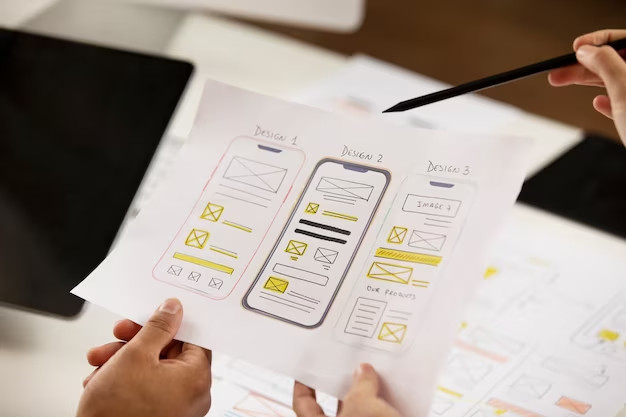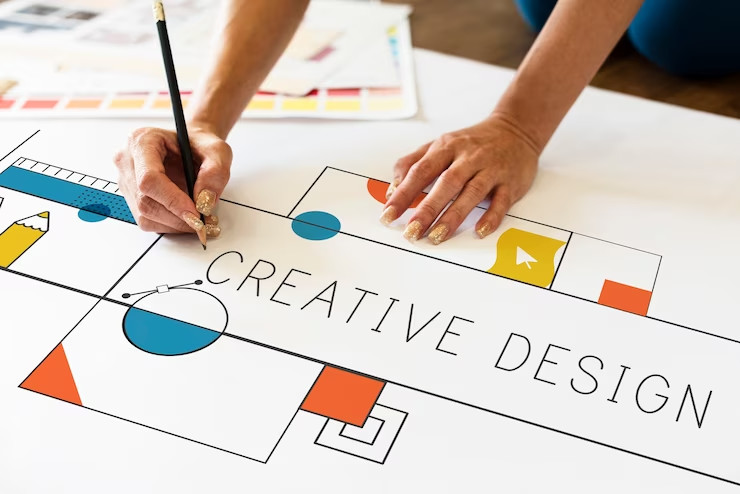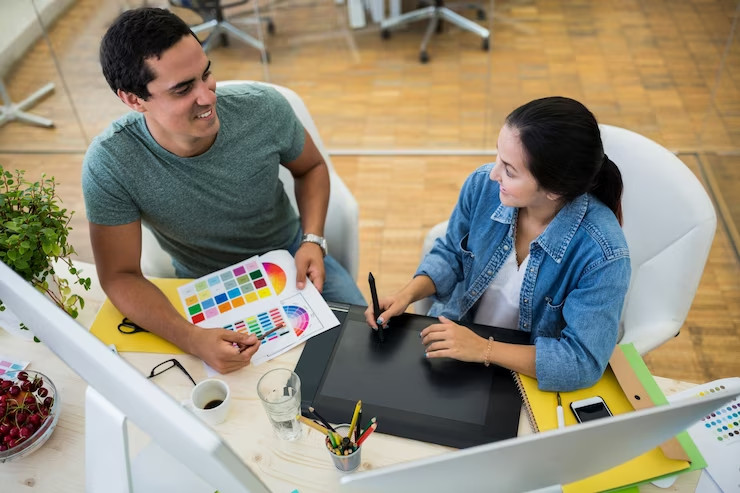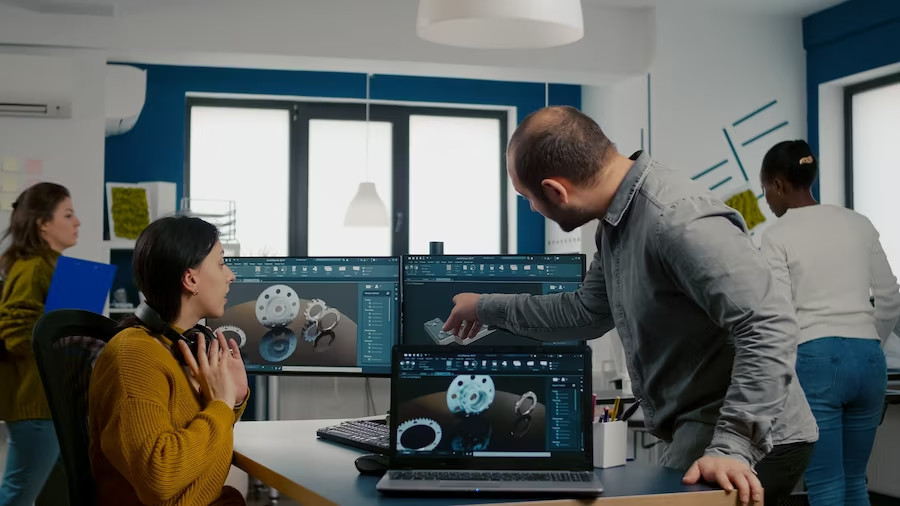Organizations and individuals alike are constantly seeking innovative solutions to complex problems. That’s where design thinking comes in! It is a powerful framework that enables us to approach challenges with creativity, empathy, and a user-centered mindset.
Design thinking is not just for designers; it’s a mindset that can be adopted by anyone looking to solve problems effectively. Whether you’re developing a new product, improving service, or reimagining an entire system, the five important stages of design thinking provide a roadmap for success.
In this blog, we will dive deep into these stages, unpacking each one to understand its significance and how it contributes to the overall design thinking process. By the end of this journey, you’ll have a solid grasp of the essential steps required to tackle problems head-on and uncover game-changing solutions.
What Is Design Thinking?
Design thinking is a methodology that encourages us to think creatively, empathize with users, and focus on their needs. It’s a process that helps us tackle complex challenges with a fresh perspective and ultimately come up with innovative solutions. At its core, design thinking is about putting people first. It emphasizes understanding the needs, desires, and frustrations of the individuals who will ultimately use the product, service, or system we’re designing.
By embracing design thinking, break free from conventional thinking patterns. We challenge assumptions, explore new possibilities, and approach problems from multiple angles. This mindset allows us to discover breakthrough solutions that have the potential to transform industries and improve people’s lives.
Read More: Why Is One Designer Not Enough? Limitations of a Single Designer
Why Is Design Thinking So Important?

Design thinking is a game-changer. It has the power to transform the way we approach problem-solving! Design thinking puts people at the heart of the problem-solving process. By prioritizing empathy and understanding, it allows us to truly grasp the needs and challenges of the end-users. Design thinking also encourages creativity and out-of-the-box thinking.
Another key aspect of design thinking is its emphasis on collaboration and teamwork. When multiple perspectives and skill sets come together, the potential for groundbreaking ideas and solutions multiplies. Each team member brings a unique background, expertise, and perspective, enriching the design thinking process and enabling comprehensive problem analysis. The diversity of perspectives ensures that the final solution is holistic, well-rounded, and caters to the needs of various stakeholders.
Furthermore, design thinking is a highly iterative and flexible process. It allows for continuous learning, refinement, and improvement throughout the problem-solving journey. By embracing failure as a stepping stone to success, design thinkers are not discouraged by setbacks but view them as valuable learning opportunities.
Read More: 15 Best Figma Tips and Tricks Designers Should Learn
5 Important Stages For Design Thinking
The process of design thinking typically involves five important stages. Each stage plays a crucial role in the overall process, guiding us through a systematic and iterative journey from problem identification to solution implementation. Here are the stages!
- Stage 1: Empathize
- Stage 2: Define
- Stage 3: Ideate
- Stage 4: Prototype
- Stage 5: Test
Stage 1: Empathize – Research About Your User’s Needs

Empathy is the key to effective design thinking. It involves putting yourself in the shoes of your users and gaining a deep understanding of their experiences, desires, and pain points. The first step in the empathize stage is conducting thorough research. This involves gathering data, conducting interviews, and observing your users in their natural environment. During the research phase, it’s essential to ask the right questions and actively listen to your users.
This step requires empathy, curiosity, and an open mind to truly connect with your users on a deeper level. The empathize stage sets the stage for the subsequent stages of design thinking. It forms the basis for defining the problem, generating innovative ideas, and ultimately creating user-centered solutions. By investing time and effort in truly understanding your users, you lay the groundwork for a successful and impactful design process.
Stage 2: Define – State Those Needs And Problems

The Define stage is all about gaining a deep understanding of the challenges at hand. To define the problems effectively, it’s important to collaborate with your team. Engage in brainstorming sessions to gain multiple perspectives, and it’s crucial to be specific and focused. Avoid vague or broad statements that make it difficult to address the root causes. Instead, aim for concise problem statements that highlight the main challenges your users face.
Consider framing the problem as an opportunity for innovation. Look beyond the surface-level issues and identify the underlying needs and aspirations that your solution can address. It’s also essential to keep the end-users at the forefront of your thinking. By staying user-centered, you increase the likelihood of creating solutions that truly make a difference. Remember, problem definition is not a one-time activity.
It’s an iterative process that evolves as you gain further insights and progress through the design thinking journey.
Stage 3: Ideate – Challenge Ideas Based On Those Needs

Ideation is the stage where creativity takes center stage. It’s a dynamic process that encourages us to think outside the box and explore diverse possibilities. The goal is to generate a wide range of ideas that have the potential to solve the defined problems. To kickstart the ideation process, create an environment that encourages participation. Set aside sessions where team members can express their ideas. Remember, every idea has value and can spark further innovations.
Sometimes the most groundbreaking solutions emerge from unexpected connections and combinations. As you progress through the ideation stage, capture and document all ideas, no matter how wild or unconventional they may seem. Use visual tools, such as mind maps or sticky notes, to organize and categorize the ideas. This visual representation helps in identifying patterns, connections, and potential areas of exploration.
Looking for documentation tools? The best ones are listed here: 24 Tools That Will Streamline Your UX Research
Stage 4: Prototype – Now Create Solutions

Prototyping is the process of transforming ideas into physical or digital representations. When it comes to prototyping, there are various approaches you can take, depending on the nature of your solution. It could involve building physical models, creating digital mock-ups, or even using simple sketches or storyboards. The key is to choose the most appropriate method that allows you to effectively communicate and test your ideas.
Prototypes don’t need to be perfect or polished. Conduct usability tests and observe how users interact with your prototypes. This feedback loop allows you to uncover potential issues! Remember, prototyping is an iterative process. Embrace a mindset of continuous learning and improvement.
Stage 5: Test – See If The Solutions Work!

Testing is a crucial phase in the design thinking process. It allows us to validate our solutions, uncover potential flaws or issues, and gain valuable insights for improvement. When it comes to testing, there are different methods and techniques you can employ, like usability tests, gathering feedback through surveys or interviews, or even observing user interactions in real-life scenarios.
During the testing phase, it’s important to set clear objectives and criteria for evaluation. Define what success looks like for your solution and establish metrics to measure its performance. This clarity will guide your testing process and help you assess the effectiveness of your designs. Consider the emotional impact of your design and how it resonates with your users on a deeper level. Strive to create experiences that are not only functional but also delightful!
Read More: Best Tips for Manual Testing of Mobile Applications
Some Benefits Of Design Thinking in Teams

Design thinking is a powerful approach that goes beyond problem-solving, it’s a mindset that can revolutionize the way we approach challenges and create solutions. Let’s explore some of the key benefits that design thinking offers:
- Enhanced User-Centricity
- Increased Creativity
- Iterative Problem-Solving
- Collaboration and Co-creation
- Human-Centered Design
- Continuous Learning and Improvement
- Customer Satisfaction and Loyalty
- Efficient Resource Allocation
- Improved Decision-Making
- Adaptability and Agility
- Competitive Advantage
- Empowered and Engaged Teams
- Risk Reduction
- Increased Employee Engagement
- Sustainability and Social Impact
- Flexibility and Adaptation
- Enhanced Problem-Solving Skills
- Organizational Innovation and Culture
- Improved Customer Insights
- Breakthrough Innovations
1) Enhanced User-Centricity
Putting the needs and aspirations of users at the center of the design process is a fundamental principle of design thinking. By empathizing with users, understanding their perspectives, and involving them in the process, we create solutions that truly resonate with their needs. Design thinking promotes a deep understanding of users, resulting in products and services that are tailored to their preferences and enhance their overall experience.
2) Increased Creativity

Design thinking encourages us to think beyond the conventional and embrace a mindset of radical ideation. It pushes us to explore diverse possibilities, challenge assumptions, and combine different perspectives to generate innovative ideas. By fostering a creative environment and embracing the ideation stage, design thinking sparks fresh insights and breakthrough concepts that drive innovation.
3) Iterative Problem-Solving
Design thinking embraces an iterative approach, where solutions are refined and improved through continuous feedback and iteration. This iterative process allows for rapid prototyping, testing, and learning, enabling us to identify and address issues early on. By embracing failure as an opportunity for learning and growth, design thinking empowers us to refine our solutions and achieve greater outcomes.
4) Collaboration and Co-creation
By engaging diverse perspectives and expertise, design thinking fosters interdisciplinary teamwork. Collaborative brainstorming, workshops, and cross-functional collaborations unlock the potential for breakthrough ideas and solutions. By bringing together individuals with varied backgrounds and skill sets, design thinking maximizes the collective knowledge and creativity of a team.
5) Human-Centered Design
By prioritizing the end-users and their needs, design thinking helps create solutions that address real-life challenges effectively. This human-centered approach ensures that our designs are functional, emotionally engaging, and meaningful to users.
Read More: Accessibility Design at Scale | Best Tips
6) Continuous Learning and Improvement
Design thinking promotes a culture of continuous learning and improvement. Through user feedback designs tend to achieve better outcomes. Design thinking encourages us to seek feedback, challenge assumptions, and remain open to new insights. By embracing a mindset of continuous learning, we can adapt and evolve our solutions to meet changing needs and preferences.
7) Customer Satisfaction and Loyalty

By placing a strong focus on understanding user needs and preferences, design thinking leads to the creation of products and services that genuinely satisfy customers. By delivering solutions that align with their expectations and provide an exceptional user experience, design thinking fosters customer satisfaction and loyalty. Satisfied customers are more likely to become advocates for your brand and contribute to its growth.
Read More: Why Is My Shopify Down? Simple and Easy Fixes
8) Efficient Resource Allocation
By understanding the core needs and challenges, design thinking enables us to allocate resources effectively and efficiently. It minimizes the risk of investing in features or functionalities that are not aligned with user requirements, allowing organizations to allocate resources in a targeted manner.
9) Improved Decision-Making
Design thinking encourages a holistic view of problems and solutions. Incorporating different perspectives and involving stakeholders in the process, it leads to better decision-making. The collaborative nature of design thinking allows for a thorough exploration of alternatives and a more comprehensive evaluation of potential solutions. This approach ultimately leads to informed, data-driven decisions that yield better outcomes.
10) Adaptability and Agility
In a rapidly changing world, organizations need to be adaptable and agile. Design thinking equips teams with the mindset and tools to respond to evolving needs and challenges. By continuously gathering feedback, testing solutions, and iterating, design thinking enables organizations to adapt quickly and stay ahead of the curve. This agility allows for the timely incorporation of new insights and ensures that solutions remain relevant in dynamic environments.
11) Competitive Advantage

Design thinking can provide a competitive advantage by fostering innovation and differentiation. Organizations that embrace design thinking are better positioned to develop unique solutions that stand out in the market. By understanding customer needs deeply and addressing pain points effectively, design thinking helps organizations deliver value that sets them apart from competitors. This advantage can lead to increased market share and business growth.
12) Empowered and Engaged Teams
Involving team members in the entire design thinking process nurtures a sense of ownership and fosters an environment where everyone’s contributions are valued. This empowerment leads to increased motivation, creativity, and job satisfaction among team members, ultimately driving better outcomes.
13) Risk Reduction
Design thinking involves a process of iterative testing and refinement, which helps identify and mitigate potential risks early on. By prototyping and testing solutions before full-scale implementation, organizations can uncover flaws or limitations and make necessary adjustments. This risk reduction approach minimizes the chances of costly mistakes or failures down the line, saving resources and enhancing overall project success.
14) Increased Employee Engagement
By involving employees from different departments and levels of the organization in the design process, their contributions are valued, and their voices are heard. This inclusivity enhances employee satisfaction, boosts morale, and encourages a sense of ownership and pride in the final solutions.
15) Sustainability and Social Impact
By considering the environmental and social implications of design choices, organizations can develop solutions that are more environmentally friendly, socially responsible, and aligned with the values of their target audience. Design thinking enables organizations to address pressing societal challenges, contributing to a more sustainable and equitable future.
16) Flexibility and Adaptation

Design thinking equips organizations with the ability to adapt to changing circumstances and market dynamics. By emphasizing an iterative and customer-centric approach, organizations can quickly respond to emerging trends, technological advancements, or shifts in customer preferences. This flexibility allows for continuous improvement and helps organizations stay relevant and competitive in dynamic industries.
17) Enhanced Problem-Solving Skills
By approaching problems with curiosity, empathy, and an open mindset, participants in the design thinking process learn to dissect complex challenges, identify root causes, and develop innovative solutions. These problem-solving skills extend beyond design thinking projects and can be applied to various aspects of personal and professional life.
18) Organizational Innovation and Culture
Adopting design thinking as an organizational approach can foster a culture of innovation, creativity, and continuous improvement. By encouraging experimentation, embracing failure as a learning opportunity, and promoting cross-functional collaboration, organizations can create an environment that nurtures and rewards innovative thinking. This culture of innovation becomes a competitive advantage and positions the organization as a driver of change and progress.
Read More: What Is Cross Platform App Development?
19) Improved Customer Insights
Design thinking facilitates a deep understanding of customer needs, desires, and pain points. Through the empathize and research phases, organizations gain valuable insights into the lives, behaviors, and motivations of their customers. This knowledge enables them to develop more targeted and effective solutions that truly resonate with their target audience. By aligning their offerings with customer expectations, organizations can enhance customer satisfaction and build stronger relationships.
20) Breakthrough Innovations

Design thinking encourages organizations to think outside the box and challenge traditional assumptions. By promoting a culture of radical ideation and divergent thinking, design thinking paves the way for breakthrough innovations. By exploring new possibilities, combining diverse perspectives, and pushing boundaries, organizations can discover unique solutions that revolutionize their industries. These innovative breakthroughs can lead to market disruption, increased market share, and long-term success.
Hapy Design goes beyond theory and actively supports the implementation of design thinking principles. Our team of experienced professionals guides organizations through the innovation process, helping them uncover new opportunities, challenge assumptions, and develop disruptive solutions. In a world where innovation is the lifeblood of success, Hapy Design is your partner in driving change, fostering growth, and unleashing the full potential of your organization.
Bottom Line
In the realm of design thinking, teams offer a lot of benefits. Collaboration, diverse perspectives, shared knowledge, and mutual support propel the design thinking process forward, leading to enhanced outcomes and innovative solutions.
So, embrace the power of design thinking in teams. Encourage collaboration, diversity, and open communication. Leverage the unique strengths of each team member to empathize, define, ideate, prototype, and test your way to groundbreaking solutions. With design thinking as your ally and teams as your driving force, you have the tools to tackle complex challenges, unleash creativity, and achieve remarkable results.
FAQs
How does collaboration contribute to the overall success of design thinking?
Collaboration in teams fosters an environment of shared knowledge, diverse perspectives, and mutual support. By working together, team members can leverage their collective intelligence, challenge assumptions, and drive innovative problem-solving. Collaboration enhances the quality of solutions, promotes creativity, and increases the chances of achieving remarkable outcomes.
Can design thinking in teams lead to better employee engagement?
Yes, design thinking in teams can significantly enhance employee engagement. By involving team members in the entire design thinking process, organizations create a sense of ownership and value individual contributions. Collaboration and inclusivity foster higher levels of engagement, job satisfaction, and a shared sense of accomplishment.
What is the role of teamwork in design thinking?
Teamwork is essential in design thinking as it brings together individuals with diverse backgrounds, skills, and perspectives. Teams collaborate to share insights, challenge assumptions, and generate innovative solutions. By leveraging the collective intelligence of the team, design thinking becomes more powerful and effective.
How can teams maximize their ideation process?
Teams can maximize ideation by creating a safe and open space for brainstorming. Encouraging divergent thinking, suspending judgment, and welcoming wild ideas spark creativity within the team. By building upon each other’s ideas, combining perspectives, and exploring different angles, teams can generate a rich pool of innovative concepts.
Can design thinking in teams lead to long-term business success?
Yes, design thinking in teams can contribute to long-term business success. By embracing collaboration and the design thinking approach, organizations can drive innovation, solve complex problems effectively, and develop solutions that meet the needs of their customers. This customer-centric approach and the ability to adapt to changing market dynamics positions organizations for sustained success.
